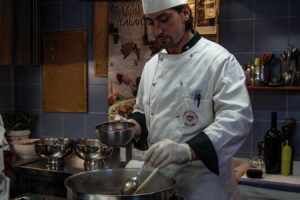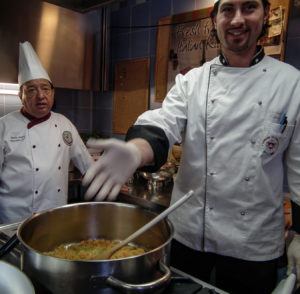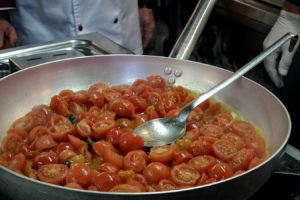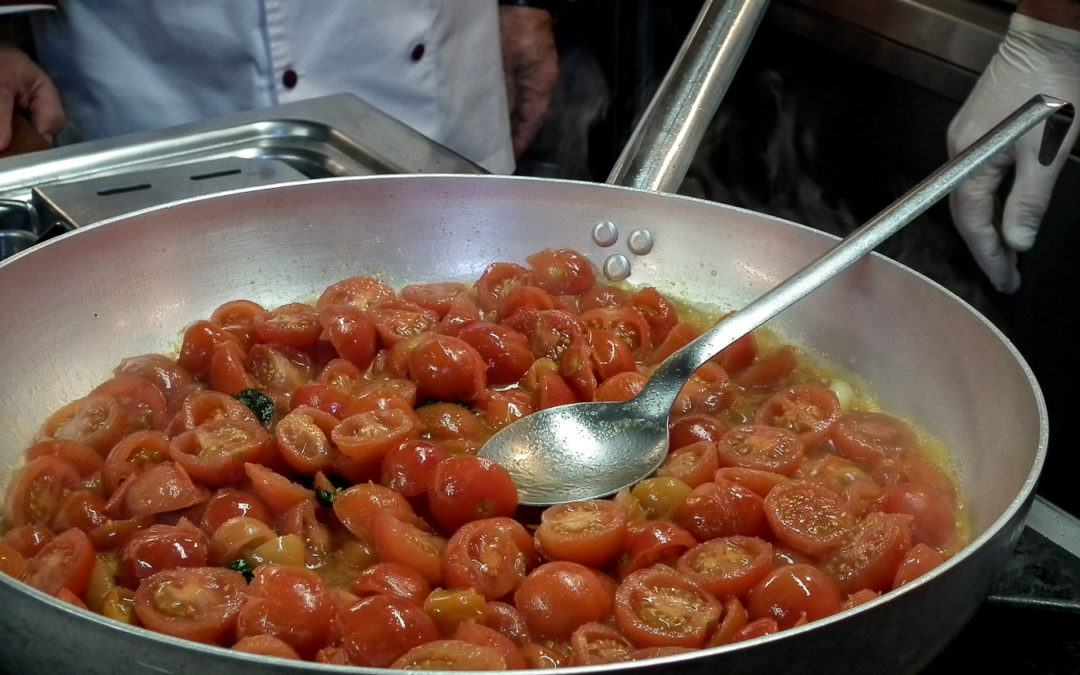In the spring of 2013, Henderson Productions was proud to travel with the experts from the restaurant chain, Olive Garden to explore as much about food and Tuscan life as possible. We’ve created this series of blogs which, like the region, should remain relatively timeless. Bon Apetito.

Chef Aldo demonstrates in the Fizzano kitchen
Fizzano Head Chef Aldo demonstrated the proper way to make Bolognese sauce. It was stressed how important it is to not leave the stove and use all senses. One must watch when the latest ingredients change color. And smell when they have released their scents. Continually stir to avoid scorching. Do not taste until the end. And ALWAYS make sure to put things in the pot in the proper order to achieve the best results! OK. Got it.
In a nutshell, olive oil to cover the bottom of the pan. Then add the finely chopped bottuto (2 sm onions/1 carrot/1 celery stalk) to that and keep stirring until the onions go translucent and release their scent. The vegetables absorb the oil until it disappears. You must have the onion smell before adding the meat – half ground pork and half ground beef. Mix them with a potato masher so while they cook, they completely blend with the soffrito. There are no big chunks in Bolognese. And keep mashing until the entire mix is lightly browned – almost grey – with no opportunity to darken stuck to the bottom. Listen for the dryness – the sizzle – telling you the pot is ready for the next ingredient.

Aldo encourages us to smell each ingredient
First, are a couple cups of dry red wine – don’t buy cheap, use the good stuff. Now you smell the alcohol burning off. Then, in off season, a half cup of canned tomato paste. If you have in season tomatoes, no paste is needed but you must have the ripest/sweetest tomatoes for the dish. Use the paste if using canned tomatoes.

Bolognese sauce has little tomato
A note about tomatoes – never purchased pre-diced or cut tomatoes in a can. You want the sweetness of summer which can only be received in a short period after tomatoes are cut. If you need winter canned tomatoes, or even if you can them yourself, use only whole and puree them or even cut them yourself. Fresh tomatoes are best literally squeezed directly into the pan but these days a food processor makes it a little less messy!
Approximately 6 cups of tomato puree are added. Stir with salt and pepper only added at this stage. Saute for 2 hours minimum and it is good to go. No herbs, no garlic. Rely on the flavor of the botutto, meat and tomato.

Pomodoro with fresh tomatoes
Then we made a fresh pomodoro sauce – the definition of a quick family meal in a rush: the sauce takes less time than the pasta. In a hot pan, cover the bottom in olive oil. Toss in an entire head of whole garlic cloves – they will be removed later so you don’t want them chopped, just get the flavor. 2 handfuls of fresh basil are then added followed by 2 quarts of cherry tomatoes cut in half. You are watching for the tomatoes to sweat juice. A big pinch of sea salt and a small one of pepper will cause even more liquid. Meanwhile, cook the pasta halfway in water, drain and then add to the pan to cook in the tomato juices for the second half of cooking. Pomodoro does not need cheese, but it can be added at the table.

Paolo and Aldo discuss the merits while waiting for the sauces to cook
About an hour later we sat down for what Paolo called a “picnic” lunch – a selection of the salami and cheeses, three or four salads of the veggies (the beef salami drizzled with olive oil and shaved pecorino Romano was unbelievable) and then spaghetti Bolognese and fettucine Pomodoro. Another local red wine and, gratefully, no dessert. Literally the fruits of our morning table.

